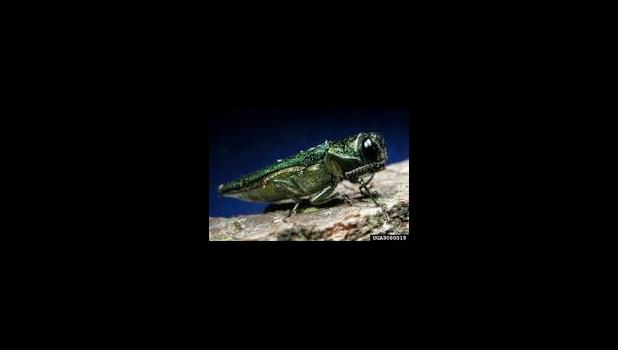Emerald Ash Borer hits Cresco
Thu, 06/15/2017 - 12:25pm
admin
Des Moines - Since the first Iowa detection in 2010, emerald ash borer (EAB) continues to expand its range across the Iowa landscape. With confirmed detections now in 50 counties, EAB has now reached more than half of Iowa counties. EAB is an exotic pest that attacks and kills ash trees.
The recent finds involve ash trees in Belle Plaine (Benton County), Alta (Buena Vista County), Charles City (Floyd County), Cresco (Howard County), and rural SW Milo area (Warren County). Insect samples were submitted from these sites and positively identified by the USDA.
For those in Howard County, there will be an public informational meeting in Cresco. Rod Freidhof, Public Works Director said, “We are hoping to have the meeting in the first half of July.” More information on the meeting will be printed in the Times Plain Dealer.
“This is traditionally the time of year we experience an increase in calls from Iowan suspecting EAB infested trees,” said Mike Kintner, Iowa Department of Agriculture and Land Stewardship EAB and gypsy moth coordinator. “Now that trees have been given the opportunity to fully leaf out for the season, the symptoms of an ash tree under attack by EAB are more noticeable.”
EAB-infested ash trees display canopy dieback beginning at the top of the tree and progressing downward, S-shaped feeding galleries under dead or splitting bark, D-shaped exit holes, water sprouts along the trunk and main branches, and bark that is stripped off as a result of woodpeckers hunting for EAB larvae.
The adult beetle is metallic green in color and measures approximately one-half inch long and can be observed during the summer months. The larvae are the damaging stage and burrow through the inner layer of bark, feeding on the vascular tissue that moves life-sustaining water and nutrients throughout the tree. Starved trees usually die within two to four years.
The Iowa EAB Team provides EAB diagnostic assistance to landowners and includes officials from Iowa Department of Agriculture and Land Stewardship (IDALS), Iowa State University Extension and Outreach, the Iowa Department of Natural Resources (DNR), USDA Animal and Plant Health Inspection Service and the USDA Forest Service. Anyone who suspects an infested ash tree in a county not known to have EAB is urged to contact the Iowa EAB Team.
At this calendar date, the treatment window for soil-applied preventive treatment measures (soil injection, soil drench, or granular application) has ended. Basal trunk sprays for trees 23 inches diameter (measured 4.5 feet above the ground) can be made until mid-June. Trunk injections can be done now through the end of August if a landowner is interested in protecting a valuable and healthy ash tree within 15 miles of a known infestation. Good ground moisture is essential for systemic insecticide movement in a tree. Full details are available in Iowa State University Extension and Outreach publication PM2084: https://store.extension.iastate.edu/product/13114
A federal quarantine, enforced by the U.S. Department of Agriculture, remains in effect and prohibits the movement of all hardwood firewood and ash articles out of Iowa into non-quarantined areas of other states without a valid compliance agreement or permit. To help reduce the spread of EAB and other destructive tree-killing pests, Iowans are strongly encouraged to use locally sourced firewood. The transport of unknowingly infested firewood is the quickest way to spread EAB to new areas.
Additional EAB information and maps are available at www.IowaTreePests.com.
For more information contact any of the following members of the Iowa EAB Team:
• Mike Kintner, IDALS EAB coordinator, 515-745-2877, Mike.Kintner@IowaAgriculture.gov
• Robin Pruisner, IDALS state entomologist, 515-725-1470, Robin.Pruisner@IowaAgriculture.gov
• Paul Tauke, DNR state forester, 515-725-8450, Paul.Tauke@dnr.iowa.gov
• Tivon Feeley, DNR forest health coordinator, 515-725-8453, Tivon.feeley@dnr.iowa.gov
• Emma Hanigan, DNR urban forestry coordinator, 515-249-1732, Emma.Hanigan@dnr.iowa.gov
• Jesse Randall, ISU Extension and Outreach forester, 515-294-1168, Randallj@iastate.edu
• Mark Shour, ISU Extension and Outreach entomologist, 515-294-5963, mshour@iastate.edu
• Laura Iles, ISU Extension and Outreach entomologist, ISU Plant and Insect Diagnostic Clinic, 515-294-0581, ljesse@iastate.edu
• Donald Lewis, ISU Extension and Outreach entomologist, 515-294-1101, drlewis@iastate.edu.
• Jeff Iles, ISU Extension and Outreach horticulturist, 515-294-3718, iles@iastate.edu


